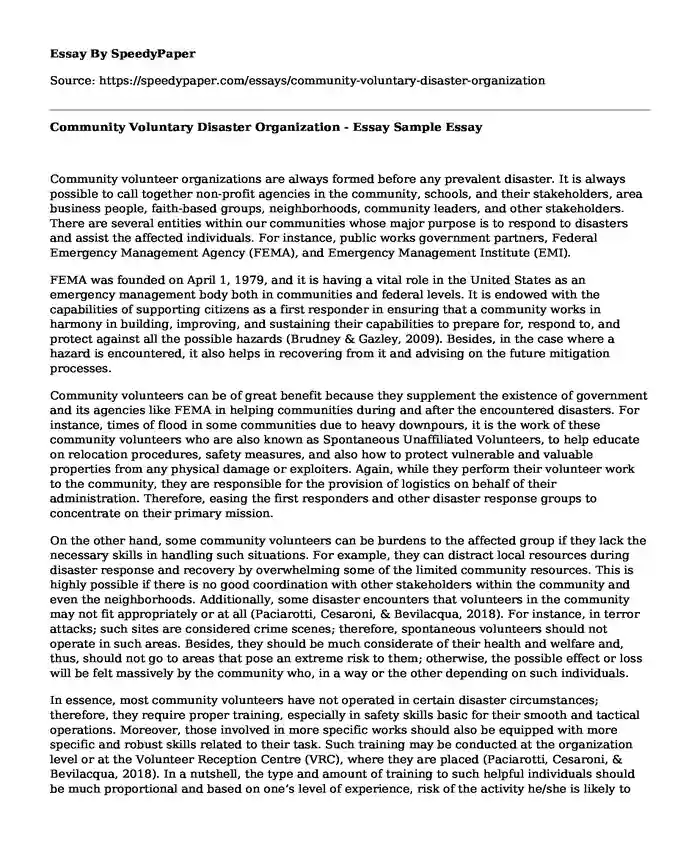Community volunteer organizations are always formed before any prevalent disaster. It is always possible to call together non-profit agencies in the community, schools, and their stakeholders, area business people, faith-based groups, neighborhoods, community leaders, and other stakeholders. There are several entities within our communities whose major purpose is to respond to disasters and assist the affected individuals. For instance, public works government partners, Federal Emergency Management Agency (FEMA), and Emergency Management Institute (EMI).
FEMA was founded on April 1, 1979, and it is having a vital role in the United States as an emergency management body both in communities and federal levels. It is endowed with the capabilities of supporting citizens as a first responder in ensuring that a community works in harmony in building, improving, and sustaining their capabilities to prepare for, respond to, and protect against all the possible hazards (Brudney & Gazley, 2009). Besides, in the case where a hazard is encountered, it also helps in recovering from it and advising on the future mitigation processes.
Community volunteers can be of great benefit because they supplement the existence of government and its agencies like FEMA in helping communities during and after the encountered disasters. For instance, times of flood in some communities due to heavy downpours, it is the work of these community volunteers who are also known as Spontaneous Unaffiliated Volunteers, to help educate on relocation procedures, safety measures, and also how to protect vulnerable and valuable properties from any physical damage or exploiters. Again, while they perform their volunteer work to the community, they are responsible for the provision of logistics on behalf of their administration. Therefore, easing the first responders and other disaster response groups to concentrate on their primary mission.
On the other hand, some community volunteers can be burdens to the affected group if they lack the necessary skills in handling such situations. For example, they can distract local resources during disaster response and recovery by overwhelming some of the limited community resources. This is highly possible if there is no good coordination with other stakeholders within the community and even the neighborhoods. Additionally, some disaster encounters that volunteers in the community may not fit appropriately or at all (Paciarotti, Cesaroni, & Bevilacqua, 2018). For instance, in terror attacks; such sites are considered crime scenes; therefore, spontaneous volunteers should not operate in such areas. Besides, they should be much considerate of their health and welfare and, thus, should not go to areas that pose an extreme risk to them; otherwise, the possible effect or loss will be felt massively by the community who, in a way or the other depending on such individuals.
In essence, most community volunteers have not operated in certain disaster circumstances; therefore, they require proper training, especially in safety skills basic for their smooth and tactical operations. Moreover, those involved in more specific works should also be equipped with more specific and robust skills related to their task. Such training may be conducted at the organization level or at the Volunteer Reception Centre (VRC), where they are placed (Paciarotti, Cesaroni, & Bevilacqua, 2018). In a nutshell, the type and amount of training to such helpful individuals should be much proportional and based on one’s level of experience, risk of the activity he/she is likely to get involved in, complexity or simplicity of the task, health, or physical demands of the task, required equipment, and policies, laws, and regulation concerned with the situation.
In conclusion, for the spontaneous volunteers to be safe and more helpful to the communities, safety and skill acquisition projected training should be abundantly provided for all volunteers before they depart from VRCs. Thus, they will perform their very primary roles professionally, hence saving a lot in terms of lives and properties.
References
Brudney, J., & Gazley, B. (2009). Planing to be Prepared: An Empirical Examination of the Role of Voluntary Organizations in County Government Emergency Planning. Public Performance & Management Review, 32(3), 372-399. https://doi.org/10.2753/pmr1530-9576320302
Paciarotti, C., Cesaroni, A., & Bevilacqua, M. (2018). The management of spontaneous volunteers: A successful model from a flood emergency in Italy. International Journal of Disaster Risk Reduction, 31, 260-274. https://doi.org/10.1016/j.ijdrr.2018.05.013
Cite this page
Community Voluntary Disaster Organization - Essay Sample. (2023, Dec 15). Retrieved from https://speedypaper.net/essays/community-voluntary-disaster-organization
Request Removal
If you are the original author of this essay and no longer wish to have it published on the SpeedyPaper website, please click below to request its removal:
- Free Essay on Healthcare Provider Faith Diversity: Christianity and Buddhism
- Are Barriers Effective in Deterring Unauthorized Migration? Free Essay
- Free Essay Comprising Presidential Speeches Analysis
- Essay Sample on Foreign Policy Analysis, Egypt's Grand Strategy
- Paper Example - Lincoln-Douglas Debates of 1858
- Essay Sample on Forces That Brought Changes in Dating Conventions Between 1900 and 1960
- Why Vaccines Should be Mandatory - Essay Sample
Popular categories





